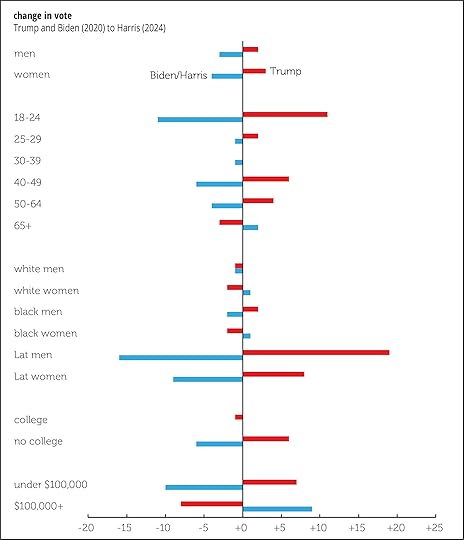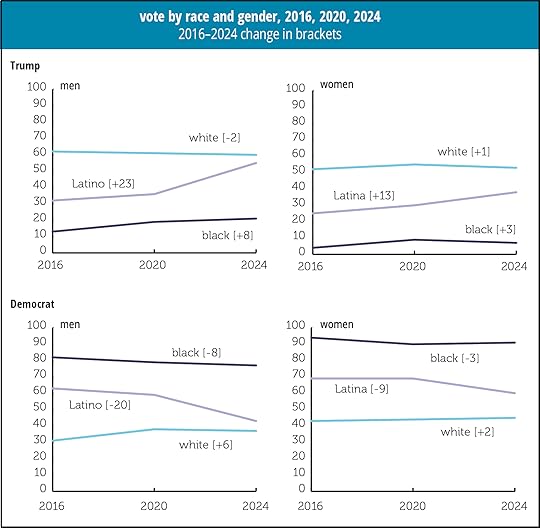Yet another parsing of the vote
If you listen to some liberals—I’m too discreet to name names, but you might know whom I have in mind—Trump’s election was the reflection of a resurgent hegemony of white patriarchy. These arguments are typically made without any supporting evidence, because there isn’t much of that. Here’s some complicating data drawn from exit polls (sources: 2016, 2020, 2024).
First, the swing between 2020 and 2024. The only demographic groups in the graph below to shift significantly towards the Democrat between 2020 and 2024 were over-65s and those with incomes over $100,000. Over-65s, often maligned as a bunch of wealth-hoarding reactionaries, went from favoring Trump by 5 points in 2020 to breaking even in 2024. (They favored Trump by 7 in 2016, though this isn’t graphed.) Over $100,000 voters went from favoring Trump by 12 in 2020 to favoring Harris by 5. (Data note: you’d need an income of $121,200 today to match one of $100,000 in November 2020, so this is only a rough comparison.)
Viewed as swings, as in the graph below, the youngest voters shifted hard from D to R (by 11 points, to be precise), as did voters without a college degree (by 6 points). Latinos shifted even harder, especially men (19 points for them, though the 8-point shift among women wasn’t trivial). Whites of both sexes shifted some away from Trump, and white women, in small numbers, towards Harris.

Changes from 2016 are also interesting, and also not what you’d guess from the standard liberal whining. The share of white men voting for Trump fell by a percentage point in 2020 and again in 2024; white women were little changed. Black men shifted 8 points in Trump’s direction over those eight years; black women, moved 3 points towards Trump. The most striking changes were among Latina women, 13 points towards Trump, and especially Latino men, 23 points. Over half of Latino men, 55%, voted for Trump last week, just 5 points short of white men’s vote. The bottom two graphs show the moves towards and away from the Dems; those are close to mirror images, but since exit polls are rough estimates and there are always candidates other than the two biggies, the inversion isn’t perfect.

Obviously there’s still plenty of racism and patriarchy in the USA, and racists and patriarchs are an important part of the Trump base. It would be otherworldly to deny either. But to claim that some joint outbreak of both explains the election result requires ignoring some actual data. What needs to be explained are the shifts among formerly reliable Democratic voting blocs, notably the young, nonwhite, and lower income.
And the argument that demographic changes in the US—notably the decline of the white population share—would guarantee a Democratic majority in the coming decades now looks very wrong. Curiously, one of the analysts most associated with that argument is now a fellow at the right-wing American Enterprise Institute.
Doug Henwood's Blog
- Doug Henwood's profile
- 30 followers



